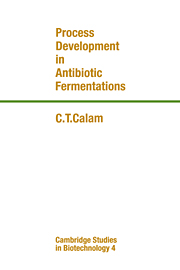Part 2 - Process development in the laboratory
Published online by Cambridge University Press: 05 February 2012
Summary
Process development work involves two main areas.
(a) The discovery and isolation of microorganisms producing new antibiotics, as a result of screening programmes, and the development of efficient fermentation processes for the production of material for testing. This usually involves the production of improved mutants and media. The object is to provide material for testing, in the laboratory and clinically. To make larger quantities of material, pilot plant fermenters are often used.
(b) Development associated with manufacture; this may be simple at first, but of increasing sophistication as yields increase. Such work is usually done in research units at the factory.
The various classes of work to be done are: (1) the planning of fermentation experiments and the gathering of data, (2) the organisation and interpretation of data, strain improvement, and selection, and (3) development of processes that give maximised results, materially and economically, using techniques that become more critical as yields increase. These subjects form the bases of the chapters in this part of the book.
While academic work tends to be speculative, as it is intended to explore and expand scientific knowledge, industrial research may seem rather narrowly based. Industrial research requires very reliable experimental apparatus and results. For this reason equipment of a high standard is customary. In a recent article, the equipment for a pilot laboratory was quoted as costing £1.5 million, illustrating the degree of elaboration involved in this type of work. Such work is demanding and also very interesting in its own right for those who like to see a new discovery brought into use as an aid to humankind.
- Type
- Chapter
- Information
- Process Development in Antibiotic Fermentations , pp. 75 - 76Publisher: Cambridge University PressPrint publication year: 1987

